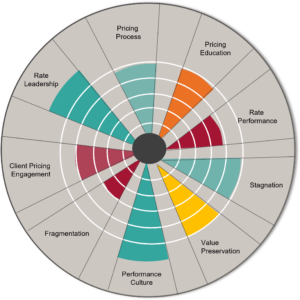Pricing is a vital topic today. And firms are often surprised when told that their current pricing approach costs them multiple millions of dollars annually, directly hitting the bottom line.[1] They are even more skeptical that meaningful gains can occur in 12 to 18 months.
In today’s economic environment, pricing errors are compounded since client discount pressures, higher costs, and demand weakness magnify the harm of those errors on firm profitability.
And pricing falls into a special class of high-impact profit drivers for the following reasons: (1) it has a magnified effect on the bottom line compared to other drivers, (2) it creates performance momentum because your lawyers can see the improvements within a short time,[2] and (3) it is a wonderful teacher of law firm performance principles and client success.
The threshold question for most leaders is, “do I have an opportunity for meaningful pricing gains?” The following discussion answers this question.
What is Your Firm’s Opportunity?
Assessing your pricing opportunity is multi-prong, encompassing qualitative and quantitative dimensions. These include testing your use of market intelligence to determine fair value, evaluating pricing process maturity, understanding your performance culture, studying your reporting and tracking capabilities, understanding your partner profit acumen, reviewing creative pricing options and success fees, understanding your pricing strategy and its connection to client development, and others, as illustrated above.
Pricing Litmus Tests
To determine your potential for pricing improvement, consider the following questions and tests that will guide you to a reasonable answer:
- Client/Matter Perspective. Do you know how well you are positioned with your clients? Do they regularly put you out to bid or push back on your rates? Do you lose value during matters via write-downs?
- Competitive Intelligence. Do you know your competitors’ rates and how they engage the market? Have they changed rates, or are they utilizing creative fee structures?
- Market Intelligence. Do you know whether your rate increases have tracked the market? I anticipate a wide variance in rate performance in 2023, as some firms push rates harder than usual while others stay cautious. This will create a market divide.
- Partner Behaviors. Do your market-leading partners price higher or lower than their peers in the market? Your leaders set the tone for the firm and position you in the market.
- Pricing Tendencies. Do you exhibit underpricing tendencies like tolerating flat rates or random discounting? Do your partners possess extended freedom to discount or take write-downs? Do you go to the market as individually priced lawyers or more like a unified brand?
- Top of Mind. Is performance a firm characteristic? Do you execute business processes that factor in good pricing and profitability? Areas to review include: (1) when you pitch, (2) when you set engagement terms, (3) at business intake, (4) during the engagement, and (5) when performing after-action reviews.
- Creative Pricing. Do you offer creative pricing arrangements to your clients to align the value of your services with their benefits? Even if you revert to traditional pricing methods, the creative pricing process can bring you closer to your clients and allow you to discuss and learn what is important to them.
- Profit Knowledge. Can you reasonably project risks and profitability for new matters and clients? Using matter metrics like fee estimates, budgets, and leakage predictors can help your teams get on the same page, understand matter risks, and orient you toward client-aligned service with a positive, predictable return.
Excellent pricing results from a good process and an active firm mindset. In today’s volatile economic environment, with higher costs and heightened competition, getting this strategic element right has never been more important. The questions above may help you determine your opportunity for better results.
[1] That translates to $100ks of profits per partner per year for most firms.
[2] Notwithstanding these are typically multi-year projects.
Posted In

